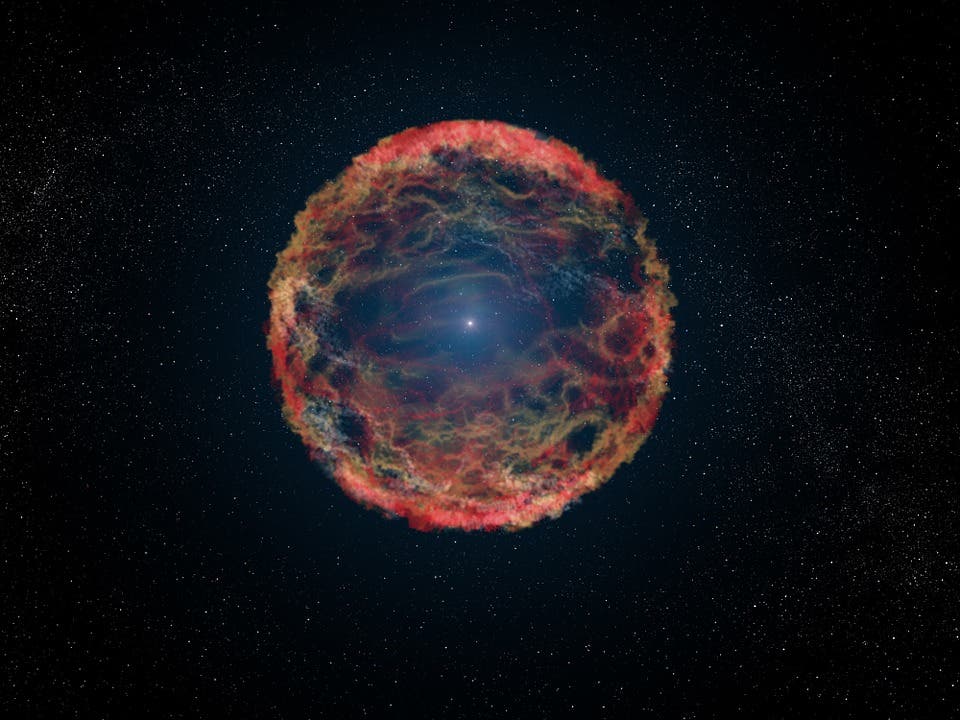
One of the most distinguishable human features is our upright mode of locomotion, which is unique among mammals. Scientists have proposed many ideas that might explain the circumstances that enabled our species to evolve as bipeds. Perhaps the most ‘out there’ theory proposed thus far comes from astronomers at the University of Kansas who claim that human bipedalism might have been triggered by giant cosmic explosions. But before you laugh, read on because, wild as it may sound, this theory has some interesting evidence backing it up.
Some time ago, scientists reported that ancient seabeds contain a layer of iron-60 isotopes. These rare isotopes cannot be made on Earth, which means their origin must be extraterrestrial, most likely the result of a supernova — a transient astronomical event that occurs during the last stellar evolutionary stages of massive star’s life. Because iron-60 has a known half-life, it is relatively easy to accurately date when the supernovae’s cosmic rays reached our planet.
Scientists traced the isotopic signatures to two major events: one 6.5 to 8.7 million years ago (300 light-years away from Earth) and the second 1.7 to 3.2 million years ago (163 light-years). That’s around the time of Homo habilis, the upright human ancestor nicknamed “handyman” because of their ability to master stone tool technology.
Based on this information, Adrian Melott and colleagues at the University of Kansas hypothesized what kind of changes these cosmic rays might have caused on Earth. One of the first things that should have happened was a dramatic increase in the rate of ionization of the lower atmosphere.
Ionization is the process by which an atom or molecule acquires a negative or positive charge by gaining or losing electrons. In this case, the cosmic rays knocked off electrons from molecules in the atmosphere. According to Melott, the supernova events would have increased ionization in the atmosphere by 50-fold. With so many free electrons in the atmosphere, cloud-to-ground lightning would have been much easier to occur, increasing the odds of forest fires.
“The bottom mile or so of atmosphere gets affected in ways it normally never does,” Melott said. “When high-energy cosmic rays hit atoms and molecules in the atmosphere, they knock electrons out of them — so these electrons are running around loose instead of bound to atoms. Ordinarily, in the lightning process, there’s a buildup of voltage between clouds or the clouds and the ground — but current can’t flow because not enough electrons are around to carry it. So, it has to build up high voltage before electrons start moving. Once they’re moving, electrons knock more electrons out of more atoms, and it builds to a lightning bolt. But with this ionization, that process can get started a lot more easily, so there would be a lot more lightning bolts.”
In time, savannas replaced torched forests in northeast Africa. Now, walking was far more advantageous for our ancestors than climbing trees. The upsurge in global wildfires is supported by the discovery of carbon deposits found in soils that correspond with the timing of the cosmic-ray bombardment.
“It is thought there was already some tendency for hominins to walk on two legs, even before this event,” said Melott, professorof physics & astronomy at the University of Kansas. “But they were mainly adapted for climbing around in trees. After this conversion to savanna, they would much more often have to walk from one tree to another across the grassland, and so they become better at walking upright. They could see over the tops of grass and watch for predators. It’s thought this conversion to savanna contributed to bipedalism as it became more and more dominant in human ancestors.”
That’s quite a great deal of speculation but the evidence suggests that such a scenario might have been possible — however improbable as it may sound. What about something like happening in the future? Slim chance, say the researchers who point to the fact that the nearest supernova candidate is now 652 light-years away from Earth. Instead, Melott says we should be cautious about a more immediate threat — solar flares.
“Betelgeuse is too far away to have effects anywhere near this strong,” Melott said. “So, don’t worry about this. Worry about solar proton events. That’s the danger for us with our technology — a solar flare that knocks out electrical power. Just imagine months without electricity.”
The findings appeared in the Journal of Geology.






